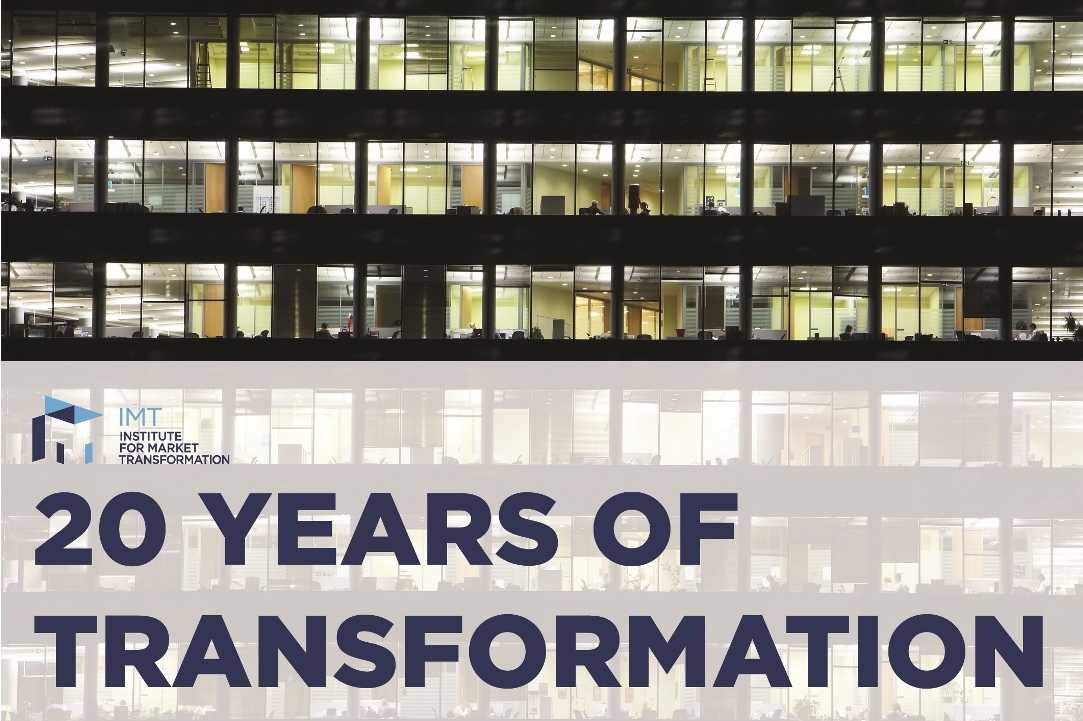In Part 2 of our 3-part series recognizing IMT’s 20th anniversary, Executive Director Cliff Majersik recalls some of the successes that exemplify our transformation work in progress. Cliff joined the organization in 2002 to manage a New York State Energy Research and Development Authority (NYSERDA) contract to work with appraisers in New York, as well as support Mark Chao to advance building energy codes in Central Asia. Catch up on Part 1 here.
One of the reasons I joined IMT, was because I saw that markets, both in the U.S. and abroad, were not accurately capturing the value of energy efficiency. The business-as-usual practices of the building industry favored lowering operating costs and tenant satisfaction—but they weren’t recognizing efficiency as a lever connected to these outcomes. So, IMT, a tiny organization, set out on the big task of discovering how we could best help move the market at scale to appropriately value and reward efficiency.
Throughout the process of false starts and small wins, we discovered that continual market engagement during the design, adoption, and implementation of energy efficiency programs and policies is a key to lasting transformation. In addition, early on, we came to the realization that cities have a unique combination of political will, autonomy, and scale to drive significant progress. This insight has helped shape IMT’s approach to reaching our vision of a future in which the social, environmental, and economic value of energy efficiency is realized and all buildings are highly efficient.
So what does market transformation look like in IMT’s 20th year? Below are just a few examples, made possible through the hard work and dedication of our incredible staff.
Transformation in Progress
IMT was a major contributor to the design and adoption of the District of Columbia’s Clean and Affordable Energy Act of 2008, which included the requirement for building owners to track and share the annual energy usage of their buildings. This law was a first-in-the-nation benchmarking and transparency policy that has now spread to 17 other jurisdictions across the country. Over time, these additional jurisdictions have built on past policy to drive efficiency improvement in the U.S. building stock.
While the adoption of strong policy builds a foundation for transformation, actual energy savings are realized through the market transformation following effective implementation of these policies. In the case of energy codes, we led a taskforce which estimated that a dollar spent on code compliance returns $6 in energy savings—a 600 percent return. With this in mind, we developed The City Energy Project Assessment Methodology for Energy Code Compliance in Medium to Large Cities to assist cities in assessing code compliance rates and identifying the areas where they should focus in order to improve those rates. The document lays out a process for identifying the factors responsible for low compliance rates, putting an improvement plan in place, and detailing effective strategies for addressing each challenge.
With all that being said, great policy or the development of effective industry standards cannot be done in a vacuum. Continual market engagement cultivates key industry partnerships and builds trust that can push a market from the inside out.
This point was made evident in IMT’s recent report, What’s in a Green Lease? Measuring the Potential Impact of Green Leases in the U.S. Office Sector. The report lays out substantial evidence that energy-aligned leases, or green leases, can open the floodgates for energy efficiency solutions—reaching potential savings of up to $3.3 Billion annually. By including a handful of new or modified clauses in a traditional commercial lease, both owners and tenants can better share costs and realize the benefits of investing in energy efficiency. However, these clauses won’t appear in leases on their own. It takes market engagement to spread the know-how necessary to make these changes.
In another recent example, IMT released a comprehensive study in partnership with the District of Columbia’s Department of Energy and the Environment that conclusively found homebuyers are both increasingly interested in high-performance homes and willing to pay more for them. While the study confirmed the value of green features in the marketplace, multiple listing services throughout the country do not adequately collect and showcase this information. However, the real estate market is now equipped with an appraiser-backed study that lays out the case for fixing this problem so that buyers can find the efficient homes they seek and home sellers won’t leave money on the table. This study builds on prior landmark IMT-commissioned research which found that mortgage default risks were on average 32 percent lower in energy-efficient homes, controlling for other loan determinants.
What We’ve Learned Informs What’s Next
High-performance buildings that actively manage their energy use have a proven record of outpacing the rest of the commercial building market; however, activity in this space does not match existing potential. Throughout the years, IMT has looked for these market inefficiencies, and we have found a general theme that access to quality information is a necessary driver to begin to fill the demand gap. As we look towards the future, we will continue to seek out and improve legacy systems through the adoption of innovative and foundational practices and policies, effective implementation, and concerted market engagement to overcome business-as-usual patterns that must be changed to slash energy usage in our built environment.

